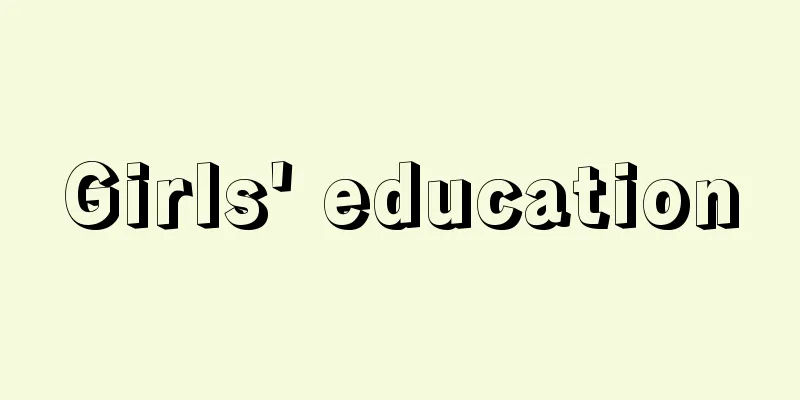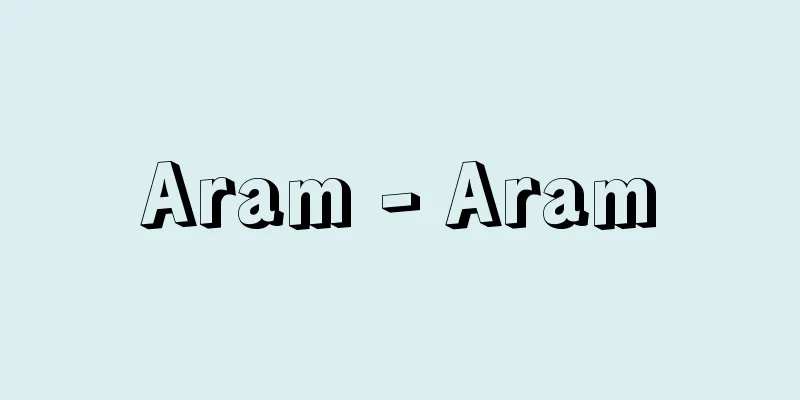Girls' education

|
It refers to education aimed at girls, but in modern nations, the central issue is equal opportunities for boys and girls in school education, rather than home education or social education, and it is considered to be related to improving women's social status. [Komata Noriaki] PremodernRegardless of whether they are Eastern or Western, women's education has traditionally been considered different from that of men, and it was customary to treat women's education with less importance than that of men's. In Japan, women were already excluded from universities and national studies in ancient times, and even in the early modern period, they had no connection to public educational institutions such as the Edo Shogunate's academic institutes and domain schools. Throughout the era of aristocratic and samurai government, women's education was mainly provided by home education or apprenticeship, and the content of education was centered on arts and crafts such as calligraphy, music, waka poetry, and sewing, with the main purpose being to prepare for married life. Since the Middle Ages, feminine virtues such as bravery and chastity have been emphasized for the daughters of samurai families, but in the early modern period, in addition to the traditional Buddhism's view of women as being despised, Confucianism, the official teaching, thoroughly promoted the idea of male superiority over women, and books of instruction for women (such as "Joshikun" and "Onna Daigaku") that emphasized servility to family and husbands were widely circulated. On the other hand, from the mid-modern period onwards, supported by the development of various industries, the number of girls attending terakoya, which were spontaneous educational institutions for the common people, increased, and "ohishiya" (needlework schools) teaching sewing also became widespread, leading to the publication of many elementary textbooks for girls (ouraimono), such as "Onna Shobai Orai". At the end of the Edo period, some people, such as Yoshida Shoin, advocated the need to establish girls' schools. [Komata Noriaki] ModernAt the inauguration of the modern public education system in 1872 (Meiji 5), the Meiji government declared the implementation of equal compulsory education for boys and girls based on the principle of equality of the four classes. The attendance rate for girls in elementary school (compulsory period of four years) had remained low, at about half that of boys, until around the time of the Sino-Japanese War (1894-1895), but in the decade leading up to the Russo-Japanese War (1904-1905) the gap narrowed rapidly, and by 1907 (Meiji 40), when the compulsory period was extended to six years, the rate had reached 96.1% for girls compared to 98.5% for boys. [Komata Noriaki] Development of Secondary Education for GirlsThe Meiji government made it a rule to separate schools for boys and girls from secondary education onwards, and this rule remained until the postwar education reforms following the Second World War. In the field of secondary education for girls, many private girls' schools were established early on, contributing greatly to the development of women's education. Girls' schools were established one after another, including Protestant schools (such as Ferris Waei Girls' School and Meiji Girls' School), which taught Christian personalism and had a significant impact on improving family life and society, practical schools (such as Atomi Girls' School) based on the traditional principle of the good wife and wise mother, Catholic schools, and Buddhist schools. In addition, many unique women's educators, such as Naruse Jinzo, Iwamoto Yoshiharu, Atomi Kakei, Yajima Kajiko, and Shimoda Utako, were produced. Many of these distinctive girls' schools were legally designated as girls' high schools in the latter half of the Meiji period, and some even developed into technical schools as higher education institutions. In the UK and the US, women's advancement into secondary and higher education began in the mid-19th century, first with teacher training institutions, but the Meiji government also focused its efforts primarily on women's normal education. From an early stage, each prefecture established women's departments or women's normal schools, and by the end of the Meiji period, out of 86 normal schools, there were 32 women's normal schools, with 2,217 women graduating compared to 5,124 men. By 1928 (Showa 3), women's normal schools had been established in all prefectures, and the advancement of female teachers was remarkable. Meanwhile, with the sudden rise in female school enrolment rates in the 1880s and 1890s and an increase in the number of girls hoping to move on to higher education, girls' high schools were gradually established, and in 1899 (Meiji 32), the establishment of such schools was made mandatory for each prefecture by the Girls' High School Act. Girls' high schools were the equivalent of boys' ordinary middle schools, but the period of study was shorter than that of middle schools, and while there were fewer hours for general subjects such as English, Japanese and mathematics, emphasis was placed on practical subjects such as sewing and housework, and a policy of "good wives and wise mothers" was adopted. After that, after the establishment of practical girls' high schools and higher courses, the Secondary School Act of 1943 (Showa 18) positioned middle schools, girls' high schools and vocational schools as equivalent secondary schools under the law. In 1895, there were only 15 girls' high schools (with 3,000 students) compared to 87 junior high schools (with 31,000 students), but by 1913 (Taisho 2), there were 330 girls' high schools (with 83,000 students, including practical girls' high schools) compared to 317 junior high schools (with 132,000 students), overtaking the junior high schools in terms of number of schools. By 1925 (Taisho 14), there were 502 junior high schools (with 297,000 students) and 805 girls' high schools (with 301,000 students), surpassing the junior high schools in terms of number of students as well. Thus, the quantitative expansion of girls' high schools during the Taisho period was remarkable. Furthermore, by 1943 (Showa 18), there were 727 junior high schools (607,000 students) and 1,299 girls' high schools (757,000 students), and if we also consider the 1,991 vocational schools (619,000 boys and 175,000 girls) that year, the number of girls enrolled in secondary schools rose to 930,000, approaching the 1.22 million boys. It goes without saying that this development in girls' secondary education before World War II was the historical premise for the realization of coeducational and compulsory junior high schools during the postwar education reforms. [Komata Noriaki] Enrolment in higher educationAs secondary education for women was established and expanded, the demand for higher education for women gradually increased, but prior to the postwar educational reforms, the government-run Women's Higher Normal School and private and public women's vocational schools were sufficient to meet this demand, and women were not allowed to go on to university as a rule. The vocational schools for women approved by the end of the Meiji period under the 1903 (Meiji 36) decree for the Technical Schools were all private schools, including Japan Women's University School run by Naruse Jinzo, Women's English Academy run by Tsuda Umeko, and Tokyo Women's Medical College run by Yoshioka Yayoi. A movement calling for the establishment of a women's university arose in the early Taisho period, and was discussed at the Provisional Education Council (1917-1919), but was not approved as it was deemed premature, and it was decided that for the time being, higher education for women would be provided within the framework of the technical school system. For this reason, even when the University Act of 1918 (Taisho 7) made it possible to establish public and private universities and public, public and private single-subject universities in addition to Imperial Universities, women's universities and women's high schools as preparatory educational institutions were not permitted. From the end of the Taisho period to the beginning of the Showa period, public and private women's vocational schools were established in Fukuoka, Osaka, Miyagi, Kyoto, Hiroshima and other cities, and the quantitative expansion of higher education for women was attempted, but no public women's vocational schools were established. Thus, in principle, the doors of universities were closed to women, but it cannot be ignored that there were a few universities that opened their doors to women. Tohoku Imperial University, which was newly established at the end of the Meiji period, was the first to admit three female students to the Faculty of Science in 1913 (Taisho 2) due to the strong will of its first president, Masataro Nagasawa. This was a breakthrough, and from the Taisho period to the early Showa period, public universities such as Hokkaido Imperial University, Kyushu Imperial University, Tokyo University of Literature and Science, and Hiroshima University of Literature and Science, as well as private universities such as Doshisha University, Meiji University, Hosei University, Toyo University, and Waseda University, began to allow women to enter university. However, the number of female students who actually enrolled was very small; in 1937 (Showa 12), for example, it was only 147 (0.3%) out of a total of 48,000 students. Nevertheless, it was significant that women were able to receive a formal university education and become active in various fields of society after graduation, and amid this trend, the Council for Education submitted a groundbreaking report in 1939 approving the establishment of women's high schools leading to universities, and the following year in 1940, the establishment of women's universities. However, due to the urgency of the situation, which continued from the Sino-Japanese War to the Pacific War, the realization of this had to be postponed until the postwar education reform. [Komata Noriaki] After World War IIThe educational reforms after World War II were also groundbreaking for girls' education. With the new junior high school system now compulsory, roughly twice as many girls were able to attend secondary education as before. [Komata Noriaki] CoeducationalFurthermore, coeducation was permitted, and equality of opportunity for men and women to advance to upper secondary and higher education was guaranteed by the system. The rate of enrollment in high school increased rapidly for both boys and girls in the 1950s and 60s, but since 1969, the rate of girls has exceeded that of boys, and in 1983 it was 95.2% for girls and 92.8% for boys, in 1998 it was 97.8% for girls and 96.0% for boys, and in 2005 it was 97.9% for girls and 97.3% for boys. In addition, in the past, different subjects were taught for boys and girls in technology and home economics in junior high schools, and home economics was compulsory only for girls in high schools, but this was criticized as fixing the traditional social roles of boys and girls, and in 1998 it became coeducational. [Komata Noriaki] Current status of higher education for womenAfter the Second World War, the advancement of women into higher education was remarkable. In 1955, the rate of enrollment in universities and junior colleges was 15.0% for men and 5.0% for women, a three-fold difference between the sexes, but by 1965 the difference had doubled, and by 1989 the ratios had reversed, with 35.8% for men and 36.8% for women. The trend of women exceeding men in the rate of enrollment in universities and junior colleges continued until 1999, when the figures stood at 48.6% for men and 49.6% for women, and the ratios reversed again the following year, with 2000 again seeing a difference of 53.1% for men and 49.8% for women in 2005. However, the rate of enrollment in four-year universities, which was lower than that of men, has been rising, and while in 1998 the difference was nearly two-fold, at 44.9% for men and 27.5% for women, in 2005 it was 51.3% for men and 36.8% for women, showing a slight tendency to narrow the gap. Looking at students enrolled in the same year, there were 1,740,151 men and 1,124,900 women (about two-thirds of the men) at four-year universities, while at junior colleges there were 28,224 men and 191,131 women (about seven times the men), with women making up 87.1% of students enrolled in junior colleges. At graduate schools, the quantitative disparity between men and women becomes even greater than at university. In addition, there is still a large bias in major fields, with fewer women in science courses at both undergraduate and graduate levels, and even within humanities courses, there are more women in literature courses and fewer in social science courses. Behind this situation lie the outdated notion that even higher education for women is ultimately preparation for marriage, as well as various issues of gender discrimination in the workplace.However, on the other hand, the situation is rapidly changing, with the number of female university students exceeding that of junior college students since 1996, the establishment of a social environment for gender equality such as the Equal Employment Opportunity Law and the Convention on the Elimination of All Forms of Discrimination against Women, which has encouraged an increase in the desire of women to go to university, and a sharp decline in the population of 18-year-olds, and it is expected that in the not-too-distant future the gender gap in university enrollment rates will disappear. [Komata Noriaki] Issues at women's universities and junior collegesRegarding women's universities and junior colleges, some say that, in the present day, all higher education institutions, including maritime universities and the National Defense Academy, have opened their doors to women, and that there is no longer any reason for their existence from the standpoint of equal educational opportunities. Others criticize that, in the present day, they are merely serving to fix the content of higher education for women at a lower level, and argue that they play a role in reproducing the traditional notion of a good wife and wise mother and perpetuating discrimination against women. On the other hand, some say that because everything is done by women at women's universities, they are more likely to foster independence and leadership than coeducational universities, and that, in the current situation where gender discrimination has not been overcome, higher education institutions specifically for women are still necessary to fully develop women's abilities and individuality and improve their social status, and that women's universities also play a large role as lifelong learning institutions for women. In addition, there are many who support the continuation of women's universities, as they are able to play an active role in both educating students and disseminating information to society in order to realize a society in which men and women participate equally, which is a modern issue, and some universities have attached research and educational facilities for women's studies. [Komata Noriaki] The decline of junior colleges and the shift to coeducational women's universitiesApart from such ideological debates, the number of junior colleges has been declining since 1996, as more and more junior colleges have been trying to convert to universities due to practical issues such as the decline in the 18-year-old population and the growing trend among women to go to universities and to coeducation. Since 1998, the number of applicants nationwide has not reached the total number of junior colleges, and there have been many cases of under-enrollment. Public women's universities are also becoming coeducational, with prefectural women's universities in Gunma, Shizuoka, Osaka, Hiroshima, Kochi, Yamaguchi, Fukuoka, and Kumamoto either merging with other universities or changing their names or reorganizing, such as Shizuoka Women's University in 1986, Kumamoto Women's University in 1994, Yamaguchi Women's University in 1996, Hiroshima Women's University in 2004, and Osaka Women's University in 2005. Private women's universities are also becoming coeducational one after another. Women's junior colleges and women's universities, which have supported the expansion and development of higher education for women since the end of World War II, are now facing difficult times, regardless of their type of establishment. [Komata Noriaki] Women's education in other countriesIn Western countries, girls' education is also differentiated from boys' education and has developed later, due in large part to the low social status of women. In ancient Greece and Rome, the Middle Ages, and early modern times, girls were not considered the target of public education, and the focus of their education was on household chores taught to them by their mothers at home. From the Middle Ages onwards, the education of upper class girls in monasteries, imperial courts, boarding schools, and religious orders also focused mainly on etiquette and the arts, with little attention paid to intellectual development. As the era progressed through the Protestant Reformation, the Civil Revolution, and the Industrial Revolution, social awareness of the need for women's education also increased. It is well known that French Revolutionary thinkers Condorcet and Lepelletier (1760-1793) envisioned equal and coeducational public education for both sexes. This was not realized immediately, but as modern public education developed in various countries, primary education for women also became common. This created a social demand for female teachers, and from the mid-19th century onwards, secondary and higher education institutions for training female teachers were developed, and then spread to other fields. At that time, while single-sex schools continued for a long time in Western European countries, in the United States, many coeducational high schools and state universities had already appeared by the mid-19th century. At first, there were many skeptical views about the abilities and physical strength of women receiving secondary and higher education, but the facts proved that the large number of girls who studied at these educational institutions were in no way inferior to men in terms of abilities and physical strength. In the 20th century, women's education has made remarkable progress, coupled with the remarkable social advancement of women, and today in developed countries such as the United States, France, and Sweden, the reversal phenomenon is even observed, with the enrollment rate of women exceeding that of men in secondary and higher education. The number of women's colleges in the United States has declined dramatically since the 1970s, but there has been a movement to reevaluate women's colleges since the 1990s. However, from a global perspective, outside of North America and Europe, there are still many countries where the compulsory education enrollment rate for girls is lower than that for boys. As a result, in these countries, the illiteracy rate for women tends to be higher than that for men, without exception. According to UNESCO statistics, the illiteracy rate for people aged 15 and over is estimated to be 0.9% for men and 1.3% for women in developed countries as of 2000, and 18.6% for men and 34.2% for women in developing countries. Thus, high illiteracy rates remain a major problem in developing countries, and this is particularly serious for women. However, it is also true that there have been steady improvements in literacy rates over the past 30 years, and behind this lies the increase in compulsory education enrollment rates and the results of literacy education for adults. There has been a remarkable improvement in both compulsory education enrollment rates and literacy education for girls, who were previously ranked lower than boys, but the gender gap in secondary and higher education is still very large. As educational standards improve on a global scale, including for boys, there is a continuing need to reduce disparities in school enrolment rates, but this will need to be accompanied by gender equality in the substantive content of education. [Komata Noriaki] "Tsuchiya Tadao, 'The History of Educational Culture Series 5: The History of Women's Education' (1954, Kaneko Shobo)" ▽ "Hiratsuka Masunori, 'The History of Women's Education Focusing on Individuals' (1965, Imperial Association of Local Government Administration)" ▽ "Umegane Satoru, editor, World Educational History Research Group, 'World Educational History Series 34: The History of Women's Education' (1977, Kodansha)" ▽ "Karasawa Tomitaro, 'The History of Female Students' (1979, Mokujisha)" ▽ "Fukaya Masashi, 'Education of the Good Wife and Wise Mother' Revised Edition (1981, Reimeishobo)" ▽ "Katayama Seiichi, 'Women's Education in Modern Japan' (1984, Kenpakusha)" ▽ "Aoki Ikuko, 'Considering Tomorrow's Women's Education -- From the Diary of a Female University President' (1990, Kodansha)" ▽ "Aoki Ikuko, 'The Hills of Mejiro' Ikuta no Mori - Towards women's education in the 21st century (1993, Kodansha) ▽ Ogawa Orie, The Beginnings of Women's Education (1995, Maruzen) ▽ Japan Women's University Women's University Research Institute (ed.), Women's Education Research Series 9: The Creation of the Modern Family and Education (1995, Domesu Publishing) ▽ Japan Women's University Women's University Research Institute (ed.), Women's Education Research Series 10: Women's University Theory (1995, Domesu Publishing) ▽ Sakamoto Tatsuro, Women's Universities in America: The Structure of Crisis (1999, Toshindo) ▽ Yamada Noboru, A Study of the History of Modern Women's Higher Education in Japan - Questioning Women's Education Today (1999, Ozorasha) ▽ Iino Masako, Kameda Fukuko, and Takahashi Yuko (eds.), The People Who Supported Tsuda Umeko (2000, Tsuda University) ▽ Takano Shun, "A Study of Girls' Primary Schools in the Early Meiji Era: The Origins of Women's Education in Modern Japan" (2002, Otsuki Shoten) [References] | | | | | | | | | | | | | | |It emphasized feudal and servile morality, such as not marrying a second husband and submitting to one's husband as if he were heaven. Published in 1848 (Koka 5) A different edition from the National Diet Library . "Women's University" Takada Toyokawa-cho, Koishikawa Ward (present-day Mejirodai, Bunkyo Ward, Tokyo). "Illustrated Guide to Famous Places in Tokyo" (1912, Meiji 45), National Diet Library Japan Women's University Source: Shogakukan Encyclopedia Nipponica About Encyclopedia Nipponica Information | Legend |
|
女子を対象とする教育をいうが、近代国家においては、家庭教育や社会教育よりも、学校教育における男女の機会均等がその中心的問題となり、女性の社会的地位の向上と関連して考えられている。 [小股憲明] 近代以前洋の東西を問わず、古来女子の教育は男子と区別して考えられ、また男子の教育より軽視されるのを通例とした。日本でも古代すでに女子は大学や国学から排除され、近世に至っても江戸幕府の学問所や藩校など公的教育機関とは無縁であった。貴族政治、武家政治の時代を通じて、女子の教養は主として家庭教育や見習奉公などによっており、その内容は書道、音楽、和歌や裁縫などの技芸を中心とし、結婚生活への準備がその主目的であった。中世以来、武家の子女には勇武、貞淑などの婦徳が強調されたが、近世になると、従来からあった仏教の女性蔑視(べっし)観に加えて、体制教学としての儒教が男尊女卑思想を徹底させ、家や夫への隷従を強調する女子教訓書(『女子訓(じょしくん)』『女大学(おんなだいがく)』など)が広く流布した。一方、近世中期以後になると、諸産業の発展に支えられて、庶民の自然発生的教育機関たる寺子屋に通う女子が増え、裁縫を教える「お針屋」も普及して、『女商売往来』など女子を対象とする初等教科書(往来物(おうらいもの))も多数出版された。幕末には吉田松陰(しょういん)など、女学校設置の必要性を説く者もあった。 [小股憲明] 近代明治政府は1872年(明治5)近代公教育体制の創始にあたって、四民平等の原則のもとに男女平等の義務教育の実施を宣言した。小学校(義務年限4年)の女子就学率は日清(にっしん)戦争(1894~1895)ごろまでは男子の半分内外に低迷していたが、日露戦争(1904~1905)にかけての10年間に両者の差は急速に縮まり、義務年限が6年に延長された1907年(明治40)には男子98.5%に対し女子96.1%に達していた。 [小股憲明] 女子中等教育の発展明治政府は、中等教育以上では男女別学を原則としたが、それは第二次世界大戦後の戦後教育改革まで変わらなかった。女子中等教育の分野では、早くから私立の女学校が多数設立され、女子教育の発展に大いに貢献した。キリスト教的人格主義の教育を行って家庭生活や社会の改良に少なからぬ影響を与えたプロテスタント系(フェリス和英女学校、明治女学校など)、伝統的良妻賢母主義に立脚した実科系(跡見(あとみ)女学校など)、カトリック系、仏教系などの女学校が次々と設立された。また、成瀬仁蔵(じんぞう)、巌本善治(よしはる)、跡見花蹊(かけい)、矢島楫子(かじこ)、下田歌子ら個性ある女子教育家が輩出した。それら特色ある女学校の多くは、明治後半期に法制上高等女学校として位置づけられ、なかには高等教育機関たる専門学校に発展するものもあった。 イギリスやアメリカでも中・高等教育への女子の進出は19世紀中葉まず教員養成機関から始まったが、明治政府が第一に力を注いだのも女子師範教育であった。各府県には早くから師範学校女子部ないし女子師範学校が置かれ、明治末年には師範学校86校のうち女子師範学校32校、卒業生男子5124人に対し女子2217人に達した。1928年(昭和3)には全府県に女子師範学校が設置されるに至り、女子教員の進出は著しいものがあった。 一方、明治20~30年代の女子就学率の急激な上昇と上級学校への進学希望者の増加により、しだいに高等女学校が整備されたが、1899年(明治32)高等女学校令により各府県にその設置が義務づけられた。高等女学校は男子の尋常中学校に対応する学校であったが、中学校より修業年限も短く、また英語、国語、数学など普通教科の時間数が少ない反面、裁縫、家事など実科に力点が置かれ、良妻賢母主義の方針がとられた。その後、実科高等女学校や高等科の設置などを経て、1943年(昭和18)中等学校令は、中学校、高等女学校、実業学校を法制上同等の中等学校として位置づけた。高等女学校は、1895年には中学校87校(生徒数3万1000人)に対して15校(生徒数3000人)にすぎなかったが、1913年(大正2)には中学校317校(生徒数13万2000人)に対して330校(実科高等女学校を含む生徒数8万3000人)となり、学校数において中学校を追い抜いた。1925年(大正14)には、中学校502校(生徒数29万7000人)、高等女学校805校(生徒数30万1000人)となり、生徒数においても中学校を上回るようになった。このように大正期における高等女学校の量的拡大は目ざましいものがあった。さらに1943年(昭和18)になると、中学校727校(60万7000人)に対して、高等女学校1299校(75万7000人)を数え、同年の実業学校1991校(男子61万9000人、女子17万5000人)を含めて考えると、中等学校に在学する女子生徒は93万人に上り、男子の122万人に迫る勢いをみせた。第二次世界大戦前のこのような女子中等教育の発展が、戦後の学制改革において男女共学で義務制の中学校を実現する歴史的前提となったことはいうまでもない。 [小股憲明] 高等教育への就学女子中等教育の整備、拡大に伴い、女子高等教育への要求もしだいに高まったが、戦後学制改革以前においては官立の女子高等師範学校と私立・公立の女子専門学校がその要求を満たしたにとどまり、女子の大学進学は原則として認められなかった。1903年(明治36)の専門学校令によって、明治末期までに認可された女子専門学校は、成瀬仁蔵の日本女子大学校、津田梅子の女子英学塾、吉岡弥生(やよい)の東京女子医学専門学校など、すべて私立であった。大正初期より女子大学設置を求める運動がおこり、臨時教育会議(1917~1919)でも議論されたが、時期尚早として認められず、女子の高等教育は当面専門学校制度の枠内で対応することとされた。そのため1918年(大正7)の大学令によって帝国大学と別に公・私立の大学や官・公・私立の単科大学の設置が可能になったときも、女子大学やその予備教育機関としての女子高等学校は認められなかった。大正末期から昭和初期にかけて、福岡、大阪、宮城、京都、広島などの公立女子専門学校や私立女子専門学校の設立が相次ぎ、女子高等教育の量的拡大が図られたが、官立女子専門学校の設立はなかった。このように大学の門戸は原則として女子には閉ざされていたが、少数ながら女子に門戸を開放した大学もあったことは無視できない。明治末年に新設された東北帝国大学が、初代総長沢柳政太郎(まさたろう)の強い意志によって、1913年(大正2)理学部に3名の女子学生の入学を許可したのが最初である。これが突破口となって、大正期から昭和初期にかけて、官立では北海道帝国大学、九州帝国大学、東京文理科大学、広島文理科大学などが、私立では同志社大学、明治大学、法政大学、東洋大学、早稲田(わせだ)大学などが、女子の入学を認めるようになった。しかし実際に入学した女子学生はごく少数で、1937年(昭和12)を例にとると、学生総数4万8000人のうち147名(0.3%)であるにすぎなかった。とはいえ女性が正規の大学教育を受け、卒業後社会の各方面で活躍するようになったことの意義は大きく、このような趨勢(すうせい)のなかで教育審議会は、1939年、大学につながる女子高等学校の設置を、翌1940年には女子大学の設置を認める画期的答申を行った。ただ、日中戦争から太平洋戦争へと続く時局の切迫のために、その実現は戦後の学制改革に持ち越されざるをえなかった。 [小股憲明] 第二次世界大戦後第二次世界大戦後の教育改革は女子教育にとっても画期的であった。新制中学の義務化により従来の約2倍の女子が中等教育を受けることとなった。 [小股憲明] 男女共学さらに男女共学が認められ、後期中等教育、高等教育への進学機会の男女平等が制度的に保証された。高等学校への進学率は昭和30~40年代にかけて男女とも急速な伸びを示したが、1969年(昭和44)以降女子の進学率が男子を上回るようになり、1983年は女子95.2%、男子92.8%、1998年(平成10)は女子97.8%、男子96.0%、2005年は女子97.9%、男子97.3%であった。また、かつては中学校技術・家庭科で男女異なる教科内容を行い、高等学校家庭科は女子のみの必修であったが、これは従来の男女の社会的役割を固定化するとの批判があり、1998年から男女共修となった。 [小股憲明] 女子高等教育の現状第二次世界大戦後、高等教育への女子の進出は著しい。1955年(昭和30)に大学・短期大学への進学率は男子15.0%、女子5.0%で、男女で3倍の格差があったが、1965年には2倍の格差となり、1989年には男子35.8%に対して女子36.8%となって男女が逆転した。大学・短期大学への進学率で女子が男子を上回るという傾向は、1999年の男子48.6%、女子49.6%まで続き、翌2000年ふたたび男女の逆転がおこり、2005年には男子53.1%、女子49.8%となっている。しかし男子にくらべて低かった四年制大学への進学率は上昇しており、1998年において男子44.9%、女子27.5%と、2倍近い格差があったが、2005年では男子51.3%、女子36.8%と、わずかながら格差が縮まる傾向にある。同年の在学者についてみると、四年制大学が男子174万0151人、女子112万4900人(男子の約3分の2)であるのに対して、短期大学では逆に男子2万8224人、女子19万1131人(男子の約7倍)となっていて、短期大学在学者の87.1%を女子が占めている。大学院になると、男女の量的格差は大学以上に大きくなる。また、学部・大学院とも、理科系に女子が少なく、文科系でも文学系に女子が多く、社会科学系に少ないという、専攻分野の偏りも依然として大きい。 このような実情の背景には、女子高等教育といえども結局は結婚のための準備であるとする旧弊な意識や、就業上の男女差別的な諸問題などの事情が伏在している。しかし他方で、1996年以降、大学の女子入学者数が短期大学のそれを上回っていること、男女雇用機会均等法や女性差別撤廃条約など男女平等に向けた社会的環境の整備、それに促された女子の大学進学志望の高まり、18歳人口の激減など、状況は急速に変化しつつあり、さほど遠くない将来に、大学への進学率における男女の格差はなくなるものと予想されている。 [小股憲明] 女子大学・女子短期大学の問題女子大学、女子短期大学については、商船大学、防衛大学校なども含め、すべての高等教育機関が女子に門戸を開放した現在、教育の機会均等の立場からみてその存在理由はすでにないとする意見や、それらは今日ではむしろ女子高等教育の内容を低位に固定化する機能を営みつつあるとする批判、あるいは伝統的良妻賢母主義を再生産し、女性差別を温存する役割を果たすという議論などがある。一方、女子大学ではあらゆることを女子だけで行うため、共学大学よりも自立心やリーダーシップが育ちやすいという見解や、男女差別が克服されていない現状では、女子の能力と個性を十分に伸ばし女性の社会的地位を向上させるためには、とくに女子を対象とする高等教育機関がなお必要であるし、女性の生涯学習機関としても女子大学の果たす役割は大きいとの意見がある。また現代的課題である男女共同参画社会の実現に向けて、学生への教育においても社会への情報発信においても、女子大学こそが積極的な役割を果たすことができるとして、女性学の研究・教育施設などを付置する大学もあって、女子大学の存続を支持する主張も多い。 [小股憲明] 短期大学の衰退と共学化する女子大学このような理念上の議論とは別に、18歳人口の減少や女子の大学志向および共学志向の高まりなどの現実問題に迫られて、大学への転換を図る短期大学が増えるなど、1996年を境として短期大学数は減少期に転じた。1998年以降、全国の入学志願者が短期大学全体の入学定員に満たない、いわゆる短大全入時代を迎え、定員割れも続出している。また、公立女子大学の共学化も進行しつつあり、群馬、静岡、大阪、広島、高知、山口、福岡、熊本にあった府県立女子大学は、1986年静岡女子大学、1994年熊本女子大学、1996年山口女子大学、2004年に広島女子大学、2005年大阪女子大学が、他大学との統合あるいは名称変更・改組により共学へと移行している。私立女子大学でも、共学へと移行する大学が相次いでいる。第二次世界大戦後、女子高等教育の拡大・発展を支えてきた女子短期大学、女子大学は、いま、その設置形態のいかんを問わず厳しい時代を迎えている。 [小股憲明] 諸外国の女子教育欧米諸国でも、女子教育は、女性の社会的地位の低さと深くかかわって、男子のそれと区別され、また遅れて発達している。古代ギリシア・ローマ時代や中世、近代初期において、女子は公的教育の対象とは考えられず、家庭で母親などから授けられる家事がその教育の中心であった。中世以降、修道院、宮廷、寄宿学校、修道会などで行われた上流子女の教育も、礼儀作法や芸能を主たる内容とし、知育はほとんど顧慮されなかった。 宗教改革、市民革命、産業革命という時代の進展のなかで、女子教育の必要性に対する社会的認識も高まっていったが、フランス革命期の思想家コンドルセやルペルシェLepelletier(1760―1793)が男女平等・共学の公教育を構想したことはよく知られている。それはただちに実現されたわけではなかったが、その後各国で近代的公教育が発達するにつれて、女子の初等教育も一般化していった。そのことがまた女子教員の社会的需要を生み、19世紀中葉以降、まず女子教員養成のための中・高等教育機関が発達し、ついで他の諸分野にも及んでいった。その際、西欧諸国では男女別学が長く続くのであるが、アメリカではすでに19世紀中葉から男女共学のハイスクール、州立大学が数多く出現している。当初は中・高等教育を受ける女子の能力・体力について懐疑的な見解も多かったが、それらの教育機関に学んだ多数の女子が、能力・体力ともになんら男子に劣らないことを、事実をもって証明したのである。 20世紀に入っての女子教育は、女性の著しい社会的進出と相まって、目覚ましい発展を遂げており、今日、アメリカ、フランス、スウェーデンほかの先進国では、中等教育や高等教育において、女子の在学率が男子のそれを上回るという逆転現象さえみられる。女子大学については、アメリカでは1970年代以降その数が劇的に減少したが、1990年代に入って女子大学を再評価する動きも出てきている。 しかし世界的視野で考えた場合、北アメリカとヨーロッパ以外では、義務教育の女子就学率すら男子のそれに及ばない国々がまだ多く存在している。その結果、それらの国々では、例外なく男性よりも女性の非識字率の方が高い傾向にあり、ユネスコの統計では、15歳以上の非識字率が、先進国においては2000年時点で男性0.9%、女性1.3%、また開発途上国においては、男性18.6%、女性34.2%と推定されている。このように開発途上国においては、非識字率の高さがいまだに重要な問題であるが、それはとりわけ女性において深刻である。しかし、この30年間に識字率の着実な改善のあとがみられることもまた事実であり、その背景には義務教育就学率の向上と、成人に対する識字教育の成果がある。義務教育就学率、識字教育とも男子よりも低位におかれていた女子において、その向上のあとが著しいが、中等・高等教育については、男女の格差はいまだきわめて大きい。 男子も含めた世界的規模での教育水準の向上とともに、引き続き就学率の格差是正が求められるが、それにはまた実質的教育内容における男女の平等が伴っていることが必要であろう。 [小股憲明] 『土屋忠雄著『教育文化史大系5 女子教育の歴史』(1954・金子書房)』▽『平塚益徳編著『人物を中心とした女子教育史』(1965・帝国地方行政学会)』▽『梅根悟監修、世界教育史研究会編『世界教育史大系34 女子教育史』(1977・講談社)』▽『唐沢富太郎著『女子学生の歴史』(1979・木耳社)』▽『深谷昌志著『良妻賢母主義の教育』増補版(1981・黎明書房)』▽『片山清一著『近代日本の女子教育』(1984・建帛社)』▽『青木生子著『明日の女子教育を考える――女子大学長の手帳から』(1990・講談社)』▽『青木生子著『目白の丘 生田の森――二十一世紀の女子教育へ』(1993・講談社)』▽『小河織衣著『女子教育事始』(1995・丸善)』▽『日本女子大学女子教育研究所編『女子教育研究双書9 現代家庭の創造と教育』(1995・ドメス出版)』▽『日本女子大学女子教育研究所編『女子教育研究双書10 女子大学論』(1995・ドメス出版)』▽『坂本辰朗著『アメリカの女性大学 危機の構造』(1999・東信堂)』▽『山田昇著『日本近代女子高等教育史考――いま女子教育を問う』(1999・大空社)』▽『飯野正子・亀田帛子・高橋裕子編『津田梅子を支えた人びと』(2000・津田塾大学)』▽『高野俊著『明治初期女児小学の研究――近代日本における女子教育の源流』(2002・大月書店)』 [参照項目] | | | | | | | | | | | | | | | |一度嫁しては二夫にまみえぬこと、夫を天として服従すること等々、封建的隷従的道徳が強調された。1848年(弘化5)刊 異版国立国会図書館所蔵"> 『女大学』 小石川区高田豊川町(現在の東京都文京区目白台)。『東京府名勝図絵』(1912年〈明治45〉)国立国会図書館所蔵"> 日本女子大学校 出典 小学館 日本大百科全書(ニッポニカ)日本大百科全書(ニッポニカ)について 情報 | 凡例 |
<<: Shokuriyamachi - Shokuriyamachi
>>: Bibliography - Shoshigaku (English spelling) bibliography
Recommend
High school
American public secondary schools. A product of Am...
Unit bank (English spelling)
…The year after the collapse of the Soviet Union ...
Yanbaru Higotai - Yanbaru Higotai
A perennial herb of the Asteraceae family native t...
Dascyllus aruanus (English spelling) Dascyllusaruanus
...They are a magnificent sight when they are gro...
Capacitance - Capacitance
It is also called electrostatic capacitance. When...
Girls' high school - koutoujogakko
These were secondary educational institutions for...
Raincoat - Ama Gappa
〘Noun〙 (kappa is capa) A cloak-like waterproof gar...
Benin City (English spelling)
A city in southern Nigeria, West Africa. Populatio...
Henry VII - Henry
King of England (reigned 1485-1509). Born of the H...
Golden Land
...A legendary golden country that the 16th centu...
Brothers-in-law
Two people who have made a promise and oath to int...
Interest-earning nation
...In areas other than production activities, the...
theorbo
...The Baroque period also saw the appearance of ...
COMSAT - Komu Sat (English spelling) COMSAT
COMSAT is the abbreviation for The Communications...
Buzen Province
The former name of the region that currently occu...









![Manticora (English spelling) [Latin]](/upload/images/67ccedf444679.webp)